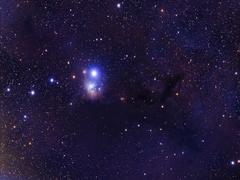Omicron Persei Cloud (Gingrich 1) B3/B4/B5/Ced20/Cr41/IC348/LBN758/VdB19 (c)
Total integration: 510m/8.5h (102 x 300s).
Camera: QH247C (24mp OSC) CMOS cooled to -15 degrees C.
Telescope: Takahashi FC100DF Steinheil fluorite doublet apochromat refractor @ f/4.9.
Reducer: Takahashi FC-35 2".
Mount: Paramount MyT.
Filters: 2" Baader UV-IR-Cut.
Software: TheSkyX Pro, Sharpcap, PixInsight.

Inline (small size) image is uploaded to the forum. Full sized image is via here:
https://www.astrobin.com/i32wrg/
The Omicron Perseus Cloud is an open cluster that is associated with some nebulosity, including dark oily patches of dust that are illuminated by a tight cluster of stars. IC348 is the designation given to 2-million-year-old star forming region (seen in the middle) with roughly 400 members that is ~1000 light years away from us.
I'm fascinated by dark nebulae/regions of space and I've been wanting to image one that had more of a three dimensional oily quality to it, unlike my previous ones with the Cocoon, Iris, and Pleiades. From my observations, dark regions/nebulae can either look like they are embedded/embossed within the sky background (see Cocoon image:
https://www.astrobin.com/414567/) or sometimes they can appear as swirls or clouds of dust around reflection nebulae (see Iris and Pleiades images:
https://www.astrobin.com/413899/ and
https://www.astrobin.com/421142/) and sometimes they can appear like an patch of oil. This nebula has all these types of dark regions (Barnard 3, 4, and 5) in the context of other reflection/emission nebulae, but the oily patch in centre-right (B3) is what attracted me to this target.
As the name suggests, this nebula/cluster is part of the constellation Perseus. Specifically the triple star system illuminating the dust is Omicron Persei, a binary pair of which are known officially as Atik (the top brightest blue one) and Ab. This nebula is part of the giant Perseus molecular cloud that is largely invisible (unlike the Orion molecular cloud) except for two star forming regions, this one and NGC1333 (also known as Embryo nebula). While not associated with this region, there are over a dozen small galaxies in the background some of which you can make out if you look closely.
The final images represent an integration of data collected over two nights. For the very first time, I had to use flat frames to remove some dust tracks/motes from somewhere in my imaging train for reasons that are not entirely clear. Normally I don't need them, but it could be due to the nature of target, since I had to bring up the background to highlight the dark regions or it could be due to my new settings. Either way, after some trial and error I made it work.
Aside from working on doing the calibration properly, there is nominal processing in the above image. An alternate version with more aggressive processing to highlight the dark nebulae is here:
https://www.astrobin.com/i32wrg/B/
Thanks for looking!
--Ram
http://ram.org









